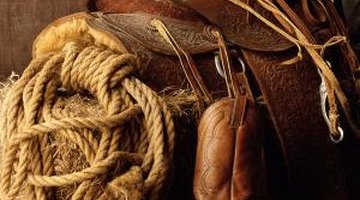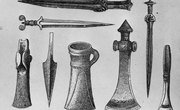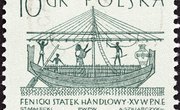"I'm known as the Poet Lariat," said humorist Will Rogers, about to perform a rope trick; the lasso, Rogers' prop of choice and the herding tool of millions of cowboys, seems to have two points of origin, so it's difficult to say which civilization can claim its invention. Like the points of similarity in Old World and New World civilizations, the lasso seems to have been created both by ancient civilizations and Native American craftsmen.
Roped in By the Ancients
Rope as an invention -- or any of its uses -- cannot be accurately traced to any one inventor. Hand-braided "rope fossils" have been found dating back 17,000 years; pictures of rope-making slaves, known as "rope-stretchers," have been found inside Egyptian burial sites. The Bible speaks of the strength of a "cord of three strands" in Ecclesiastes 4:12, which is an illustration of progressive thought in the area of its usage. If, in the ancient mindset, three-strand rope was better than two-strand, the thought of using the rope for a lasso wasn't far away.
Lassos in Egypt and Rome
The lasso itself can probably be traced to ancient Egypt; the Pharaoh Seti I is depicted in a relief drawing wielding one to bring down a sacred bull. It evolved into a gladiatorial weapon, the noose used by the Laquerarius, a Roman warrior-showman. Wielded by this agile, lightly armored champion, a lasso was an effective weapon for bringing down and destroying an enemy if used with a thrusting dagger. It was eventually replaced by a net, which meant an easier catch; the warrior needed less precise coordination to ensnare an opponent.
Lassos in the New World
As with many Old World-New World phenomena, the lasso developed along similar lines in America. Native Americans were using lassos when European explorers set foot in the New World; like their Roman counterparts, the natives were quite skilled at lassoing Spanish conquistadors. Once the Spanish introduced horses to the New World, Native Americans improved on the weapon's agility by attacking on horseback, which accounts for the lasso's current use in rodeos. African slaves in Mexico roped cattle with lassos; these laborers, captured by the Spanish, were employed as herders, the first real cowboys.
Pecos Bill, True Inventor
So who was the true inventor of the lasso? Cowboy-tall-tale tellers insist it was Pecos Bill, the Texas cowpoke raised by a mama coyote, who, when he started herding cattle, invented brands to keep the cows separate, then invented horseback riding to maneuver more successfully, and finally invented the lasso to tame the wilder members of the herd. He did it all, the storytellers insist, and was the original "Poet Lariat," before the advent of Will Rogers.
Related Articles
References
Writer Bio
Michael Stratford is a National Board-certified and Single Subject Credentialed teacher with a Master of Science in educational rehabilitation (University of Montana, 1995). He has taught English at the 6-12 level for more than 20 years. He has written extensively in literary criticism, student writing syllabi and numerous classroom educational paradigms.











